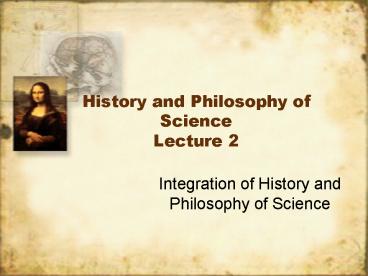History and Philosophy of Science Lecture 2 - PowerPoint PPT Presentation
1 / 26
Title:
History and Philosophy of Science Lecture 2
Description:
What is an integrated historical and philosophical study of science? ... Science as the activities of scientific practitioners (account of the journey) Explanatory ... – PowerPoint PPT presentation
Number of Views:385
Avg rating:3.0/5.0
Title: History and Philosophy of Science Lecture 2
1
History and Philosophy of Science Lecture 2
- Integration of History and Philosophy of Science
2
Section Selections
- No sections this week, Section Assignments will
be posted on the Classes Server by the weekend - On signup sheet
- Indicate 1st, 2nd, 3rd, 4th Choices
- Indicate impossible times
- Possible Section Times
- Tuesday 130-220
- Tuesday 330-420
- Wednesday 1030-1120
- Wednesday 330-420
3
Questions to be addressed
- What are the ways that historians and
philosophers study science? - What is an integrated historical and
philosophical study of science? - What might such a study look like in a specific
instance?
4
Science Two Views
- Science as results (view from the summit)
- A collection of facts
- Accepted knowledge of the natural world
- Public presentation of the finished work
- Science as the activities of scientific
practitioners (account of the journey) - Explanatory
- Contextual
5
History of Science
- Approaches
- History of ideas
- Social History
- Psychohistory
- Methods
- Historiography
- Biography
- Narrative
6
Philosophy of Science Three Flavors
- External (no need of warrant from science)
- 1. General development from epistemology and
metaphysics - 2. Logical structure of knowledge
- Internal
- 3. Takes warrant from actual practice of science,
hence depends on historical analysis
7
The PSI Program
- Epistemology of Science
- Belief, skepticism, justification, confirmation
- Ontology of Science
- Nature of being, reality, existence
- Philosophy of Nature
- Understanding of the world requires taking
science seriously
8
A Case Study Structure of Matter
9
Textbook Model of Atom(Niels Bohr, 1913)
10
Atomic Structure before Bohr
- Regularities of Periodic Table (since early
1800s) - Spectra revealed something was moving inside the
atom - Atoms could break up by ionization emitting
electrons - Some atoms could break up by radioactive
disintegration
11
Some Key Problems
- How can all those electrons stay together with
their repulsive forces? - Only apparent solution was for electrons to move
in some non-uniform (i.e, not straight line)
way. - Non-uniform motion of charge (by classical
physics) produces radiation (light or heat), so
eventually the atom will run out of energy and
be unstable
12
Experimental Data Spectroscopy to the Rescue
- Rainbows
- Prisms
- Spectroscopy was big in the 19th C.
- Line Spectra
- Spectra suggested an atomic signature
13
Simple Spectroscopy
14
Absorption and Emission Spectra
15
Models of Atoms
- Models in science
- Visual, Mathematical, Topological
- Often anthropomorphic
- Macroscopic vs microscopic
- Model has some, but not all, homologies to nature
- Model can suggest further experiments (heuristic
quality)
16
Models of Atoms
- J.J. Thomson (1856-1940)
- Cambridge England
- Plum pudding model
- Accounts for charge neutrality
- Does not account for radiation loss problem
17
Rutherfords Scattering Experiment (actually done
by Marsden and Geiger)
Ernest Rutherford (1871-1937) Manchester and
Cambridge England
18
Rutherfords Atom
Very heavy nucleus accounts for scattering Does
not account for radiation loss problem
19
Bohrs Atom
- Niels Bohr (1885-1962)
- Copenhagen, Manchester and Cambridge
- Post-doctoral fellow with J.J. Thomson and then
with Ernest Rutherford - Son of famous physiologist
- Studied philosophy with Harald Høffding
- Attacked the problem of the frequency and speed
of orbital motion of Rutherfords electrons
20
Bohrs Atom
- We shall introduce a hypothesis, from which we
can determine the quantities in question. This
hypothesis is that there for any stable ring
(any ring occurring in the natural atoms) will be
a definite ratio between the kinetic energy of
the electron and the time of rotation. This
hypothesis, for which there will be given no
attempt at a mechanical foundation (as it seems
hopeless), is chose as the only one which seems
to offer a possibility of an explanation of the
whole group of experimental results which gather
about and seems to confirm conceptions of the
mechanisms of the radiation as the ones proposed
by Planck and Einstein
21
Bohrs Atom
- Quantized Energy Levels
- Transitions between them account for spectra
22
Balmer Spectrum for Hydrogen(Johan Balmer, 1885)
23
Bohrs Atom and Spectroscopy
- Balmers Series and Balmers Formula
- Bohrs model allows derivation of the Balmer
Formula and predicts the Balmer Spectral lines - Conclusions Hydrogen atom has only one electron,
electron energies are quantized
24
Historical Issues
- What was the context in which Bohr work?
- What knowledge did he build upon?
- Was he creative? And in what ways?
- How did he understand his work in relation to
that of other scientists? - Did his philosophical views impact his scientific
views? - .
25
Philosophical Issues
- What was Bohrs view of reality?
- Did he value precedent?
- What was the role of experiment and evidence in
Bohrs thinking? - How did Bohr interact with his colleagues and
mentors? - How did he evaluate ideas, theories and data?
26
Section Selections
- No sections this week, Section Assignments will
be posted on the Classes Server by the weekend - On signup sheet
- Indicate 1st, 2nd, 3rd, 4th Choices
- Indicate impossible times
- Possible Section Times
- Tuesday 130-220
- Tuesday 330-420
- Wednesday 1030-1120
- Wednesday 330-420

